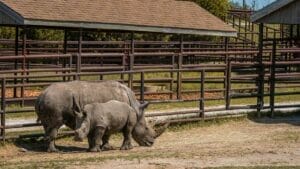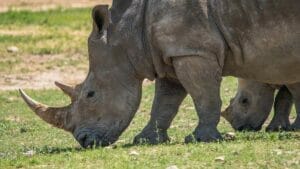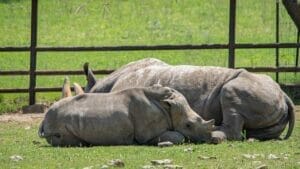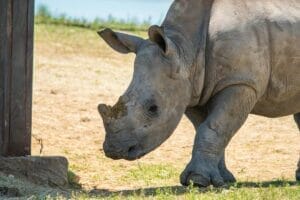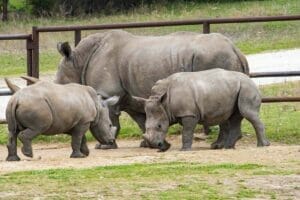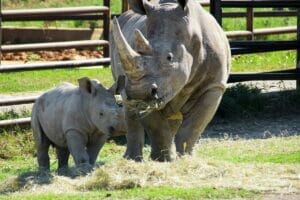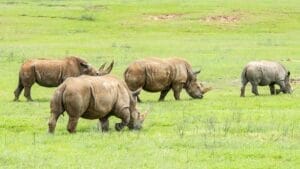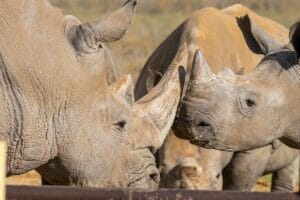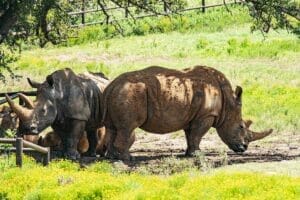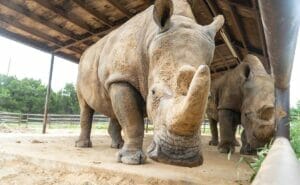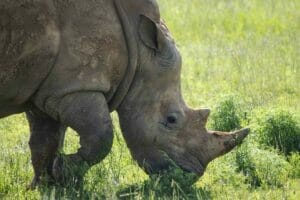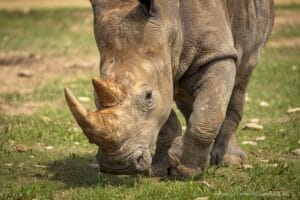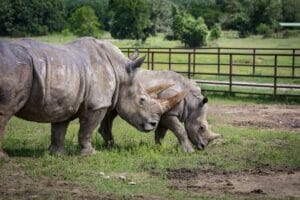
Appearance
The white rhino gets its common name not from its color, and is instead derived from an early Afrikaans word describing its mouth: “weit,” or wide. Its broad, square lips and expansive muzzle, as well as its size, distinguish it from the smaller, prehensile-lipped black rhinoceros.
With their wide mouths, white rhinos are adapted for grazing short turf grasses on the savanna.
Their head hangs down low to the ground, and they look up only when alarmed.
White rhinos have two horns on the end of their nose. The front horn is usually much larger than the inner horn.
Adaptations
The white rhino has poor eyesight, but keen hearing and smell, though they are fairly docile, they are very aggressive when threatened or startled and can charge at speeds of 35 mph.
White rhinos love mud. They will roll around in it, cover themselves with it, and cover their young with it. The wet mud cools them and protects their skin from sun and insects.
Unlike black rhinos, white rhinos are semi-social and territorial. They stay together in herds on the grassy plains and mark their territory by urine spray and dung scattering along the perimeter.
Conservation
Poaching remains the greatest threat to the white rhinoceros. Its horn is used in Asia for traditional medicines and, more recently, as a status symbol for the wealthy. Rhino poaching is part of the global black market in illegal wildlife trade, one of the biggest black markets today.
Of the rhinos that survive in the wild, almost all are southern white rhinos – 96 percent of which reside in South Africa. There are currently only two northern white rhinos (both females) left in the world – including in the wild and in captivity. The northern and southern subspecies, which appear similar, have been genetically separated for two million years.
Breeding the southern white rhino has been notoriously difficult, with only a few facilities being successful. Facilities able to maintain larger social groups typically see greater success. Reproductive research using ultrasonography was pioneered at Fossil Rim, and is being used by other organizations and researchers to continue the fight to save the southern white rhino.
Where are they?
They live in a yard in the first pasture you enter, but you will actually encounter them toward the end of your trip and you return to the pasture to complete the loop.
VIEWING TIPS
White rhinos live in herds, and will be more active if the weather is cool or if it has recently rained.
Quick Facts
Scientific Name | Ceratotherium simum simum |
Species Survival Plan | Yes |
Habitat | Grassland or savannah |
Food | Grasses |
Originally Native To | Southern and eastern Africa |
Weight | 4,000 - 7,000 lb. |
Characteristics | Second-largest land mammal; wide mouth; two horns; neck hump |
Lifespan | Wild 30 years |
Social Behavior | Males are territorial and solitary; females are not territorial and prefer the company of another female or calf |


